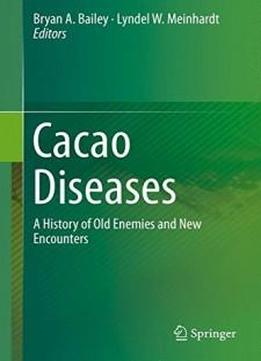
Cacao Diseases: A History Of Old Enemies And New Encounters
by Bryan A. Bailey /
2016 / English / PDF
13.7 MB Download
This book reviews the current state of knowledge concerning cacao
pathogens and methods for their management.
This book reviews the current state of knowledge concerning cacao
pathogens and methods for their management.
Topics discussed include the history, biology and genetic
diversity of
Topics discussed include the history, biology and genetic
diversity ofMoniliophthora
Moniliophthora species (which cause
witches’ broom and frosty pod rot) and
species (which cause
witches’ broom and frosty pod rot) andPhytophthora
Phytophthora
species (which cause black pod rot) that cause diseases resulting
in major losses to cacao production. Emerging pathogens such as
species (which cause black pod rot) that cause diseases resulting
in major losses to cacao production. Emerging pathogens such asCacao swollen shoot virus
Cacao swollen shoot virus and
andCeratobasidium
theobromae
Ceratobasidium
theobromae (which causes vascular streak dieback) are also
discussed in detail, along with many pathogens of significant
local concern. Most of these pathogens represent major risks to
global cacao production should they expand into new areas,
breaking out of their current limited distributions. By
considering cacao diseases as a group, similarities in the
available tools and techniques used in their management become
apparent, as do their limitations. Gaps in our current knowledge
of cacao pathogens and the management of the diseases they cause
are detailed, and suggestions for future research directions are
provided. This insight allows readers to consider cacao disease
threats from a more comprehensive, global perspective and paves
the way for an improved synergy of efforts between the various
research programs, agencies, and industries, both private and
public, with vested interests in cacao production, and cacao
farmers.
(which causes vascular streak dieback) are also
discussed in detail, along with many pathogens of significant
local concern. Most of these pathogens represent major risks to
global cacao production should they expand into new areas,
breaking out of their current limited distributions. By
considering cacao diseases as a group, similarities in the
available tools and techniques used in their management become
apparent, as do their limitations. Gaps in our current knowledge
of cacao pathogens and the management of the diseases they cause
are detailed, and suggestions for future research directions are
provided. This insight allows readers to consider cacao disease
threats from a more comprehensive, global perspective and paves
the way for an improved synergy of efforts between the various
research programs, agencies, and industries, both private and
public, with vested interests in cacao production, and cacao
farmers.











